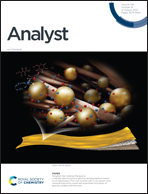A flexible electrochemical glucose sensing platform based on an electrospun PVA mat covered with in situ grown silver nanoparticles and a mixed self-assembled monolayer of glucose oxidase and ferrocene†
Abstract
An electrochemical glucose sensor based on flexible materials is significant for wearable devices used for real-time health monitoring and diagnosis. However, applying flexible electrodes involves complex fabrication processes and might reduce detection sensitivity. To overcome these obstacles, we herein report a novel strategy for preparing a highly flexible enzyme electrode based on an electrospun poly(vinyl alcohol) (PVA) mat decorated with in situ grown silver nanoparticles (nano-Ag) for electrochemical glucose sensing. Ferrocene (Fc) was selected as an electron acceptor for glucose oxidase (GOD) in order to minimize the influence of oxygen. Electron transfer between GOD and Fc was facilitated by confining them within a mixed self-assembled monolayer (SAM) formed on a thin layer of gold deposited on top of the PVA/nano-Ag film. Nano-Ag was found to significantly increase the surface area of the electrode and improve the stability of electrode conductivity during tensile deformation. Electrochemical glucose detection was performed by chronoamperometry in the electroactivity domain of ferrocene, and good linearity (R2 = 0.993) was obtained in the range of 0.2–7 mM with a detection limit of 0.038 mM and a relative standard deviation (RSD) of 1.45% (n = 6). After being stuck to a bendable PDMS slice and bent, respectively, at 30° and 60° 50 times, the electrode showed slight changes in detection results (<4.78%), which remained within 8% when the bending angle increased to 90°. With its high flexibility, good detection performance, and convenient fabrication process, the proposed enzyme electrode showed good potential as a flexible platform for wearable glucose sensing systems.



 Please wait while we load your content...
Please wait while we load your content...